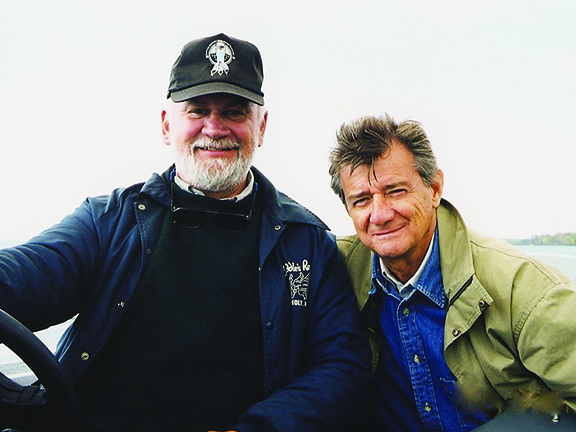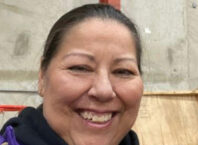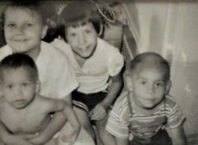By Jim Lenfestey
Here are a few facts and stories readers should know from the long, wondrous life of Ronald Lee Libertus (‘Gitchi-nibi”) who walked on April 24th after a short, surprising encounter with acute myeloid leukemia a few days short of his 80th year.
Born on the White Earth Reservation April 29, 1938, Ron grew up in Onigum on the Leech Lake Reservation. A talented athlete, he arranged his own rides to track meets since Walker High School had no track team.
He earned a track scholarship to Macalaster College in St. Paul.
He left Macalaster after a year for the Air Force. Stationed in Europe during the Cold War, he learned Russian and served as a translator while playing basketball for his division all over Europe. Returning to the US, he transferred to the University of Minnesota where he graduated with a degree in Russian Studies.
He worked for Honeywell.
He signed the incorporation papers for the American Indian Movement, which he helped found with Harold Goodsky, Gerry Vizenor, George Mitchell and Bonnie Wallace. They met with the Mayor and chief of police and organized patrols. “They changed Franklin Avenue forever,” said Wallace.
He chaired planning and development of the Minneapolis American Indian Center, the first such facility in the nation, and later organized a fund to preserve the George Morrison mural there.
He organized the first American Indian art show at the Walker Art Center, a joint exhibit with Minneapolis Institute of Arts (now mia).
With his Dakota friend Mike Oker he organized the first contemporary American Indian art show at mia.
He served as liaison to the Minnesota Department of Natural Resources to preserve the state’s wild rice resource.
He taught Native American art history for sixteen years at the University of Minnesota, where he brought native artists into the classroom, and took students to Arizona and New Mexico to study with native artists there. Upon his retirement in 2001, the University awarded him an honorary Doctor of Humane Letters.
In the summers he and his family owned and operated a resort on Leech Lake, where he guided fishing trips and washed dishes.
For many years he taught in the winters at Rollins College, Florida, where he and his wife Judy kept a fishing boat.
He was truly a man for all seasons.
Bob Rice, Ron’s cousin and owner of PowWow Grounds in Minneapolis, said Ron, his father’s wild ricing partner, was a “great storyteller and was a very generous human being who didn’t want people to know how much he did.”
Ron’s nephew Greg Ballanger, of Northland Visons, remembers Ron duck hunting, fishing and ricing on Leech Lake with his Dad. “He was my favorite uncle,“ Greg says.
Art teacher and flutemaker Jeff Chapman (Ojibwe) remembers Ron trained him to take over his Native American Art class at the University, which Jeff taught for twenty years. “Everything in public about Ron was funny,” Jeff said, “but he was an immense scholar. Everyone who found out about Ron’s passing cried. Then the funny stories started. Which is what Ron wanted: ‘No sad stories.’”
Jill Ahlberg Yohe, contemporary curator at mia, says Ron was “a trendsetter.” He reached out to artists in the native community, and founded an art bus to take art to the community. “What an impact that had.”
Among the stories his friend the scholar and author Gerry Vizenor (White Earth) remembers, is the time in the early 70’s they drove to South Dakota to do something about the capital punishment conviction of Thomas James White Hawk. “That gray afternoon on the dusty highway near Sioux Falls a huge eagle bounced on the front of Ron’s station wagon, and left feather prints spread across the hood to the headlights. Ron pulled over immediately, but there was no trace of the eagle. We decided to consider the collision a positive warning, and together we saved the life of Thomas James White Hawk.”
Dr. Brenda Child (Red Lake Ojibwe), Chair of American Studies at the U of MN, adds: “Ron was a fantastic colleague in the Department of American Indian Studies when I first arrived at the University over two decades ago. Ron and Judy Libertus were our greatest champions and supporters even after his retirement. I feel lucky to have been his friend.”
Ron and Judy quietly supported countless other native organizations and individuals, including Leech Lake Tribal College, The Circle newspaper, and Good Acres community farm, which is setting up a honorary CSA in his honor.
Famous for his gentle nature, robust athleticism, “fantastic” storytelling, immense scholarship, community connections, sense of humor and quiet competitiveness, Ron was friends with all and enemy of none.
My own Ron story is short for a friendship of nearly 40 years, “Ron Libertus was one of the finest people I have ever known.”
Ron is survived by his wife Judy, son Ron II, daughter Sarah, two grandchildren and a tribe of friends and organizations astonished at their good fortune to have known him, bereft at his abrupt departure to the spirit world, but filled with joyous tales of his remarkable and generous life.
Memorials should be sent to the Libertus-Rice Transfer Student Recruitment Fund at the University of Minnesota Foundation.
James P. Lenfestey is journalist, poet, former editorial writer at the StarTribune, and former chair of the board of The Circle.







